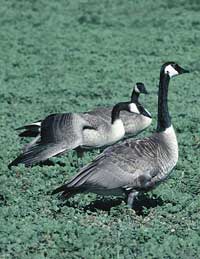Canada Goose Information
General Considerations for Resident Goose Control
The loss of wariness by resident Canada geese to people often makes goose control challenging. While there are a variety of techniques used to disperse geese from problem areas, each provides varying degrees of success. Of the various methods described herein, some techniques will work for some groups of geese and have no effect on others. General guidelines include:
- Discontinue feeding or any other unnecessary activity that may be attracting geese. Feeding concentrates birds, conditions birds to be less wary of humans and renders most dispersal techniques ineffective. Canada geese are very capable of finding their own forage, making well intentioned hand-outs unnecessary.
- Try different dispersal methods or combine multiple methods. Decoys, such as owls and coyotes, placed in areas geese are utilizing can discourage congregating or feeding geese. Decoys should be moved often to prevent conditioning and keep birds vigilant of changes. Other techniques that contribute varying degrees of success can include the use of remote controlled watercraft, dogs and disturbance by people in kayaks, canoes or other watercraft.
- Be persistent. Initial efforts need to be continuous and will require a dedicated commitment. Until the geese find food and cover in another location, they may try to return. Ineffective or haphazard harassment may be counterproductive by training the birds to be non-responsive.
- It is more effective and easier to disperse birds from an area when they first arrive. Diligent dispersal efforts should be initiated prior to the nesting season (February-March). Forced dispersal during the nesting, brood rearing and adult flightless stages (May-July) will be very difficult.
- If birds return to an area after being successfully dispersed, meet them with a hostile reception. Returning birds should be easier to disperse the 2nd and subsequent attempts.
- Be aware that domestic ducks and geese will attract resident flocks of Canada geese to an area, especially if food is provided for the domestic flock.

